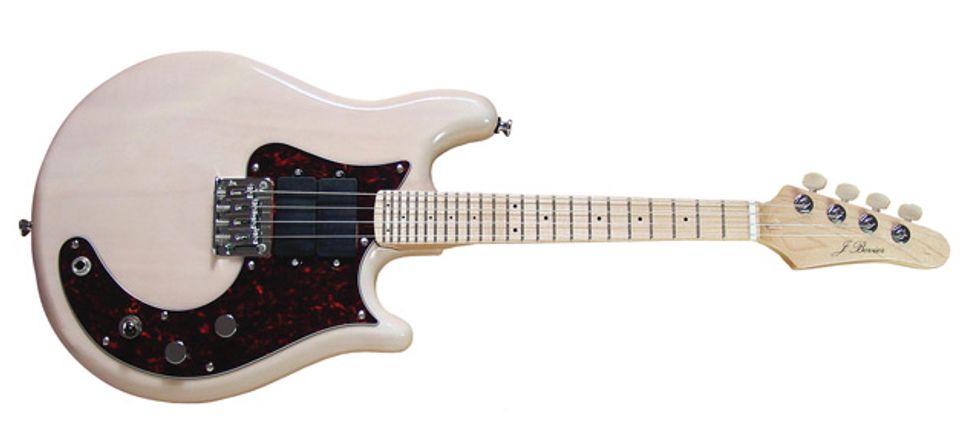Aside from having to think in fifths rather than fourths, mandolin players
have two enormous obstacles: First, a great mandolin costs a small
fortune. Second, acoustic mandolins are very difficult to amplify—they
seldom sound anything like a mandolin once you plug them in, and you
usually have to cut a hole in a beautiful instrument to install a pickup.
JBovier attempts to rectify the aforementioned mandolinist dilemmas.
Company founder Jeff Cowherd began building mandolins in 2005
with the goal of putting quality instruments in the hands of budget-strapped
players. JBovier mandolins have since developed a reputation
for exceptional fit, finish, and value—but more importantly for their
extraordinary tone and volume.
Cowherd’s electric mandolins were designed with the same principles in
mind. The prototypes were first displayed at 2009 Summer NAMM, and
they received numerous accolades from accomplished mando players
there. Production began soon afterward, and the three models—the
ELS, EMC, and EMC-5—were officially launched in early 2010.
The Specs
I test-drove an EMC in vintage cream, and the perfect finish
has a subtle, vintage-ish vibe. It owes much of its design inspiration
to the four-string Fender Mandocaster introduced back
in 1956. However, the body is more contoured, so it’s more
ergonomic than the flat Fender design. It also features individual
saddles, which makes setup very easy and accurate—
kind of like on a modern Tele.
The old rule that you can’t beat stock Fender pickups from the
1950s clearly does not apply to mandolins. I played a ’57 Fender
Mandocaster at a recent guitar show, and it was terrible. JBovier
went to considerable effort to improve on it by including a pair of
new, proprietary JB-53 pickups, which are stock on all JBovier e-mandos.
The JB-53s look like little active humbuckers, and they were created
as distinct neck and bridge units. They’re controlled by a three-way
switch, and each has a ceramic magnet and a much wider internal rail that fits four- or five-string mandolins for a very
even output. In the neck and bridge positions,
they function as single-coils, but they become
a true humbucker in the center position. The
tone of this center position can be catered to
taste by raising or lowering the pickups.
Let’s Take Her for a Spin
I tested the EMC by plugging it into an L.R.
Baggs direct box and then into a PA. Then I
went caveman, plugging it straight into my
guitar amp. My conclusion is that it’s a very
cool e-mando, but that it’s probably not
going to fool anybody into thinking they’re
listening to a well mic’d acoustic mandolin.
But that’s not the point. The EMC’s unique
tones put a very cool spin on mandolin parts.
I liked it best run straight into my guitar rig.
The output is on par with a medium-output
electric guitar, and the effects that I usually
use with my electric guitars added a fun
dimension. If you’re in a situation where you
need to switch between electric guitar and
mandolin—or if you’re primarily an electric
guitarist but you’ve been looking for a way to
mix things up in your band—the EMC is a very
practical tool.
My favorite tone was the neck
pickup, with the tone knob rolled back a bit.
Although I experimented with other pickup
settings, once I found that one, I didn’t move.
My band’s front-of-house man liked the ease
of this system because, rather than running
a separate mandolin line and having to unmute
the mando line when I switched, he just
sat back and listened as my mandolin parts
blasted from my guitar amp. I loved the ease
of switching. My mandolin mix was exactly like
my guitar mix, and I could control my volume
for solos just like I can with my guitar. In short,
the EMC eliminates many of the technical
hassles guitar players face when switching
between guitar and mandolin.
The Final Mojo
JBovier has taken a good idea from Fender’s
heyday and made it actually work. For a gigging
electric player who needs a mandolin
part to cut over a loud drummer, the EMC is a
practical and affordable solution. I loved it.
Buy if...
you play mandolin with a loud band.
Skip if...
you are a full-time bluegrass player.
Rating...
Street $679 - JBovier - jbovier.net |







![Rig Rundown: Russian Circles’ Mike Sullivan [2025]](https://www.premierguitar.com/media-library/youtube.jpg?id=62303631&width=1245&height=700&quality=70&coordinates=0%2C0%2C0%2C0)

















